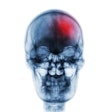
Oropharyngeal cancer (OPC) patients treated with combined chemotherapy and radiation therapy reported a decrease in their voice and speech quality (VSQ) for up to one year after completing treatment, according to research presented at the recent Multidisciplinary Head and Neck Cancer Symposium in Scottsdale, AZ (International Journal of Radiation Oncology, February 1, 2014, Vol. 88:2, pp. 470-471).
The study also showed that limiting the dose of radiation to the glottic larynx (voice box) to less than 20 Gy resulted in a decrease in post-treatment VSQ problems, and that patient-reported VSQ indicated more adverse effects from treatment compared with independent physician assessment.
 Jeffrey Vainshtein, MD, Department of Radiation Oncology, University of Michigan.
Jeffrey Vainshtein, MD, Department of Radiation Oncology, University of Michigan."The most notable finding of our study is that radiation dose to the larynx and oral cavity was independently associated with changes in voice and speech quality, respectively, and that these changes were much more common when reported by patients as compared to assessment by their physicians," lead study author Jeffrey Vainshtein, MD, chief resident at the University of Michigan Department of Radiation Oncology, told DrBicuspid.com.
The study evaluated the VSQ of 91 patients with stage III/IV oropharyngeal cancer at the University of Michigan (U-M). The patients were treated from 2003 to 2011 on two prospective studies of definitive concurrent chemotherapy and radiation therapy (CRT), using advanced intensity-modulated radiation therapy (IMRT) techniques intended to minimize the radiation dose to the pharyngeal constrictors, salivary glands, oral cavity, glottic larynx, supraglottic larynx, and esophagus.
Patient-reported VSQ was assessed using questionnaires by U-M and the University of Washington (UW). Patients completed questionnaires prior to treatment and one, three, six, 12, 18, and 24 months after CRT. Factors associated with worsening patient-reported VSQ were assessed and defined as a decrease in scores from the patients' baseline evaluations.
A maximum decrease in VSQ was reported at one month post-treatment, with 68% of patients reporting worsening U-M scores and 41% reporting lower UW scores. The scores improved later, with patients on average reporting scores back to baseline by 12 months post-treatment on U-M scores and by 18 months post-treatment on UW scores. At 12 months after treatment, however, a third of patients continued to report a decrease in VSQ compared with baseline, with 33% showing lower U-M scores and 28% showing lower UW scores.
Radiation Oncology, University of
Michigan
In contrast, the study found that physician assessments were much less sensitive to voice and speech problems at post-treatment, with VSQ reported (grade 1 toxicity) by physicians in only 5% of patients at three months and 0% at either one or two years.
Dr. Vainshtein attributed the discrepancy between patient and physician reporting of voice and speech changes following CRT to several factors.
"It has become evident in recent years across multiple disciplines of medicine that patient reported outcomes often reveal more subtle aspects in which patient quality of life is affected by medical treatments than is appreciated by their physicians," Dr. Vainshtein explained. "These differences are likely due to minimization of such subtle effects by both patients and clinicians during routine follow-up assessment, which are only elicited on specific detailed questioning as performed in the quality of life questionnaires completed by patients in our study. Although the severity of voice and speech changes reported by patients after CRT was of low severity, the fact that these changes were strongly associated with radiation dose to the larynx and oral cavity clearly suggests that further refinements in our radiation techniques are likely to decrease even these subtle effects after CRT for head and neck cancer patients."
On further analysis, voice quality worsening (as reported by patients) was closely related to the radiation dose received by the glottic larynx, while patient-perceived speech difficulty was related to radiation dose received by both the glottic larynx and oral cavity. Worse patient-reported scores at six months post-treatment were correlated with mean radiation dose to the glottic larynx, with 25% of those whose glottic larynx received less than 20 Gy, 33% who received more than 20-30 Gy, 59% who received more than 30-40 Gy, 50% who received more than 40-50 Gy, and 64% who received more than 50 Gy reporting worse scores at six months compared with pretreatment.
The association of worse scores with dose to the glottic larynx persisted at the 12-month post-treatment mark, as reported by 10% of patients whose glottic larynx received less than 20 Gy, 32% receiving more than 20-30 Gy, 25% receiving more than 30-40 Gy, 30% receiving more than 40-50 Gy, and 63% receiving more than 50 Gy (x2 for trend p = 0.02 at six months, p = 0.011 at 12 months).
"Our results suggest that minimizing the radiation dose to the voice box and oral cavity in situations where they are not at risk of involvement by cancer are likely to reduce voice and speech problems, and thus improve post-treatment quality of life, for patients treated with chemoradiation for head and neck cancers," Dr. Vainshtein concluded. "More broadly, our findings serve as a reminder of the critical role that patient-reported outcomes must continue to play in guiding modifications to our current therapies."
The 2014 Multidisciplinary Head and Neck Cancer Symposium was sponsored by the American Society for Radiation Oncology (ASTRO), the American Society of Clinical Oncology (ASCO), and the American Head & Neck Society (AHNS).



















